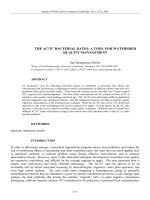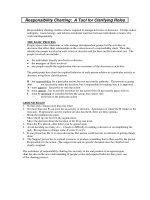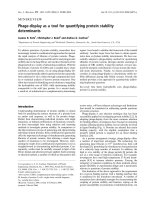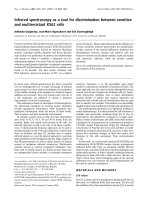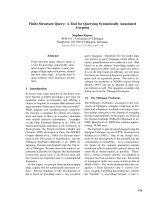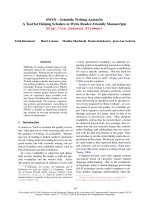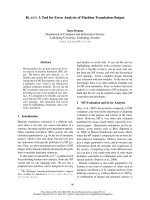ILO PARTICIPATORY GENDER AUDIT: A tool for organizational change docx
Bạn đang xem bản rút gọn của tài liệu. Xem và tải ngay bản đầy đủ của tài liệu tại đây (303.07 KB, 8 trang )
ILO
PARTICIPATORY
GENDER AUDIT
A tool
for organizational
change
Gender Audit of the UN Agencies
in Zimbabwe and Mozambique
A participatory gender audit is a tool and a process based on a participatory methodology to
promote organizational learning at the individual, work unit and organizational levels on how to
practically and effectively mainstream gender.
A gender audit is essentially a “social audit”, and belongs to the category of “quality audits”,
which distinguishes it from traditional “fi nancial audits”. It considers whether internal practices
and related support systems for gender mainstreaming are effective and reinforce each other and
whether they are being followed. It establishes a baseline; identifi es critical gaps and challenges;
and recommends ways of addressing them, suggesting possible improvements and innovations.
It also documents good practices towards the achievement of gender equality.
A gender audit enhances the collective capacity of the organization to examine its activities
from a gender perspective and identify strengths and weaknesses in promoting gender equality
issues. It monitors and assesses the relative progress made in gender mainstreaming and helps
to build organizational ownership for gender equality initiatives and sharpens organizational
learning on gender through a process of:
Team building
Information sharing
Refl ection on gender
Follow-up action on the gender audit’s recommendations is crucial and this is where the
ownership of the audit by the Work Unit/Offi ce is important in advocating, intervening and
scaling up action.
Often a gender audit works as an entry point for discussing wider substantive and operational
concerns. Several “beyond gender” issues become highlighted, such as the organizational
culture of overwork; long hours at the offi ce; time pressures; the ‘bead curtain syndrome’ (where
people are only in contact vertically with their superiors and peers); and the lack of proactive
structures for sharing, learning and adapting. These features in an organization’s culture are
particularly unfavourable to the promotion of gender equality.
WHAT IS AN ILO PARTICIPATORY
GENDER AUDIT?
“The Offi ce must now work to ensure that commitment to gender equality
is internalized throughout the ILO and refl ected in all our technical work, operational
activities and support services”.
Juan Somavia, Director General, ILO
•
•
•
In October 2001, the ILO launched the fi rst series of groundbreaking participatory gender
audits in accordance with the ILO Gender Mainstreaming Policy. This was the fi rst exercise of
its kind to be introduced in the United Nations system. The objective of these gender audits
was to promote organizational learning on how to implement gender mainstreaming effectively
in the policies, programmes and structures of the institution and to assess the progress made
in achieving gender equality.
In the fi rst series of gender audits (2001-2002), the main focus was on auditing ILO Offi ces and
increasing gender awareness and capacity among all those involved in planning and delivering
ILO projects and programmes. A global desk review of 700 key ILO policy documents and
major publications provided quantitative and verifi able information.
Between 2003 and 2005, a new dimension was added by extending the audits to major ILO
constituents, such as the International Confederation of Free Trade Unions (ICFTU) Secretariat
in Brussels and four constituent organizations in Sri Lanka. The aim was to reach out to
decision-making bodies at the policy level.
A total of 25 Units/Offi ces have been audited since 2001 to 2005 (10 work units and
programmes at ILO Headquarters, and 15 Field Offi ces in South and South East Asia, the
Middle East, Europe, Africa and Latin America).
Gender audits were also conducted in several UN agencies in Zimbabwe at the request of the
Inter-agency Group on Gender in Harare. These audits contributed to enhancing individual and
joint efforts to promote gender equality in their various interventions.
Three intensive Training of Facilitators (TOF) were organized in Colombo and Harare. This
resulted in a multiplier effect and the creation of a “pool” of trainers who are building capacity
among local gender experts and focal points.
A BRIEF HISTORY OF ILO PARTICIPATORY
GENDER AUDITS
•
•
•
•
•
Commission on the Status of Women, 49th Session (Beijing +10)
The ILO was invited to share its gender audit experiences and lessons learned in boosting
gender mainstreaming within its own structures and among its constituent members with
national delegates, donor agencies, UN representatives and civil society groups at the 49th
Session of the Commission on the Status of Women (Beijing +10).
Venn Diagram
Identifi es to what extent an organization’s relationships
with internal/external partners and stakeholders are
driven by gender equality concerns.
Hofstede’s Onion
Identifi es, by peeling away layers of an imaginary onion,
the prevailing work culture within an organization
vis-à-vis gender equality.
GENDER AUDIT METHODOLOGY
The methodology followed in the gender audit is based on four pillars of current thinking on
gender and organizational change: learning organization theory, qualitative self-assessment, adult
experiential learning cycle, and gender and development approach.
An ILO Participatory Gender Audit Manual guides the audit by addressing
the following 12 key elements:
Current gender issues, debate and relationship to the national gender machineries
Mainstreaming as a cross cutting concern within the institution’s objectives, programme and budget
Mainstreaming in implementation of programmes and technical cooperation activities
Existing gender expertise and competence
Information and knowledge management on gender issues
Systems and instruments in use for accountability, evaluating and monitoring on gender equality
Choice of partner organizations
Advocacy products and public image
Decision-making on gender mainstreaming
Staffi ng and human resources concerning gender balance and gender-friendly policies
Organizational culture and its effects on gender equality
Perception of achievement on gender equality
Examples of Participatory Exercises
A BRIEF HISTORY OF ILO PARTICIPATORY
GENDER AUDITS
•
•
•
•
•
•
•
•
•
•
•
•
Examples of Participatory Exercises
Layer 1
Symbols/Artifacts
Layer 2
Champions/Leaders
Layer 3
Rituals
Layer 4
Values
• Unit/Office volunteers for gender audit and sends request to Bureau for Gender
Equality
• Formal commitment is made on audit dates, focal point contact set up in Unit/Office
• Audit team members are selected and pre-audit preparations set in motion
• Document review begins two weeks prior to audit meetings with the Unit/Office
• Audit duration in Unit/Office is for two full weeks with an audit team of 3-4 members.
Participatory workshops, interviews, briefings and consultations with constituents are
all undertaken within this period
• Audit draft recommendations are discussed with the entire Unit/Office on last day of the audit
and Action Plan set up
• Draft report is submitted to Unit/Office within a month for comments on factual details
• Report is completed within the following month
• Unit/Office is responsible for initiating implementation of audit recommendations
• Bureau for Gender Equality is accessible thereafter for technical assistance and advice on
implementation of recommendations
Though committed in principle to gender equality,
conceptual clarity on gender concepts and gender
mainstreaming found to be rather limited
Gender is still considered an “add on” – need to
make it “visible”, “specific”, “explicit”, “concrete”
and integrated
Limited exposure to gender mainstreaming tools
and methodologies
How to integrate gender into technical areas is
the “million dollar question” posed by all
Need to develop mechanisms for accountability
on gender mainstreaming
Lack of specific gender indicators that would help
track progress made or obstacles encountered
Lack of consistency and sustainability of gender
mainstreaming throughout institutional structures
and mechanisms
Need for management to explore ways of highlighting
and giving recognition to good practices in gender
mainstreaming
GENDER AUDIT PROCESS
Gender equality built into the monitoring and
evaluation of ILO’s shared objectives
Project documents examined through a “gender filter”
Flexible working time and working from home
arrangement to promote family friendly workplace
Improved efforts at gender mainstreaming in
technical cooperation projects
New user-friendly tools on gender and child labour
published
Advocacy strategies for promoting gender equality
in IPEC Programmes strengthened
Gender focal team set up to monitor implementation
of audit recommendations
Country-specific vision on gender equality
and gender mainstreaming strategy developed
Key Findings Positive Outcomes
In 2004, gender audits were carried out with four constituent organizations
in Sri Lanka: the Ministry of Labour and Employment, Employers’ Federation
of Ceylon (EFC) and two trade union federations, Ceylon Workers Congress
(CWC) and Sri Lanka Nidahas Sewaka Sangamaya (SLNSS).
Following completion of the audits, a meeting was held with all participating partners to share
lessons learned on effective solutions to gender gaps. Linkages were made with the ILO’s Decent
Work Agenda and Plans of Action were set up for each of the audited institutions. This intensive
exercise drew attention to various measures and strategies that could be used to address gender
equality issues in the national context of Sri Lanka.
GENDER AUDITS OF ILO CONSTITUENTS
The fi rst major ILO gender audit of an international federation was carried
out with the ICFTU in 2005. It was also the largest single gender audit
facilitated by the ILO to date.
The call for an ICFTU gender audit came with the resolution “Unions for Women, Women
for Unions” which was adopted at the 18th ICFTU World Congress in December 2004. The
gender audit was perceived as a signifi cant step towards furthering the ICFTU’s work to
promote gender equality.
The fi ndings and recommendations of the audit were reported to the ICFTU Executive Board in
December 2005. A Plan of action was discussed in the Women’s Committee in March 2006.
The International Confederation
of Free Trade Unions (ICFTU)
National Gender Audits in Sri Lanka
“The gender audit opened our eyes to the constant need to be responsive
to gender equality in trade union activities.”
Mr. Leslie Devendra, General-Secretary, Sri Lanka Nidahas Sevaka Sangamaya (SLNSS), Sri Lanka
“The gender audit paved the way for a broader debate on equality issues
within our organisation, not only related to gender, but also in terms of the wider
organisational culture.”
Mr. Gotabaya Dasanayaka, Director General, Employers’ Federation of Ceylon (EFC), Sri Lanka
Initiatives in Sri Lanka after audit:
• Gender Bureau set up in Ministry of Labour and Employment, vision and mandate determined,
roles and budget clarifi ed and activities initiated
• Role and status of Women’s Division in SLNSS strengthened
• Gender task forces set up in all audited units effectively monitoring implementation of audit
recommendations
“Although the gender audit covered the ICFTU Secretariat only, the exercise raised
issues that have broader implications for the whole confederation. It taught us that we
have still some way to go to ensure our programmes and activities are mainstreamed,
but it also showed us that we are slowly moving in the right direction.”
Helen Creed, Chairperson, ICFTU’s Women’s Committee
The ILO gender audit has added impetus to the process of integrating gender equality into the
ILO by setting in motion an institutional learning mechanism. The challenge now is to rigorously
monitor the implementation of its recommendations.
The ILO constituents and the UN system are increasingly interested in conducting gender audits
in order to accelerate gender mainstreaming within their own organizations. ILO is responding by
modifying and revising the audit methodology to meet their specifi c needs.
The ILO will focus on conducting Training of Gender Audit Facilitators (TOFs) at the regional and
national levels to help enhance the capacity of local experts in carrying out audits to strengthen
institutional mechanisms for gender equality promotion. Gender audits are also planned to
be conducted with labour related institutions such as labour market institutions, employment
services, social security systems and labour inspectorates.
THE WAY FORWARD
FOR ILO PARTICIPATORY GENDER AUDIT
Between 2004 and 2005, gender audits were conducted in several UN
agencies in Harare, Zimbabwe: FAO, ITU, UNAIDS, UNDP/UNIASU,
UNESCO, UNFPA, UNICEF, WFP and WHO. The World Bank also
participated.
In Mozambique, ILO assistance was provided for a gender audit of the UNDP Offi ce in Maputo.
Gender Audit of the UN Agencies
in Zimbabwe and Mozambique
“At the UN Country Team level in Zimbabwe, the gender audit strengthened
our capacity to institutionalise gender equality in our policies, programmes and
structures.”
Mr Agostinho Zacarias, Resident Coordinator, UN Country Team, Zimbabwe
Impact of UN audits (2004):
• Sensitization on gender strengthened within UN agencies
• Gender equality issues receiving more focus in interventions with national partners
• Gender task force set up to monitor gender equality
The primary goal of the ILO is to promote opportunities for women and men to obtain decent and
productive work in conditions of freedom, equity, security and human dignity. The ILO considers
gender equality as a key element in its vision of Decent Work for All Women and Men for social
and institutional change to bring about equity and growth.
Reporting directly to the Director-General, the ILO Bureau for Gender Equality acts as a catalyst
and adviser for ILO Constituents and staff to be more effective in increasing gender equality in the
world of work, thereby advancing decent work as a global goal. It also serves as the liaison with
the ILO Governing Body concerning gender issues within the organization.
The Bureau conducts participatory gender audits within the offi ce and among its constituents.
Gender audits provide a rigorous and collective self-assessment of progress and gaps in
institutionalizing gender mainstreaming – within the ILO or national institutions – and develops
recommendations on how to enhance the process.
Through technical cooperation, the Bureau works to strengthen the gender mainstreaming
capacity of ILO constituents at country level and offers targeted support. The Bureau also
coordinates knowledge sharing initiatives on gender equality and publishes an electronic
newsletter, the ILO Gender News.
The Bureau coordinates the ILO Gender Network and also acts as liaison in relations concerning
gender issues with the UN system, NGOs and academic and women’s organizations.
ILO BUREAU FOR GENDER EQUALITY
Contact for further information:
Bureau for Gender Equality
International Labour Offi ce
4, route des Morillons
1211 Geneva 22
Switzerland
Tel: +41 22 799 6730
Fax: +41 22 799 6388
e-mail:
www.ilo.org/gender

